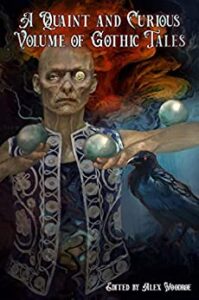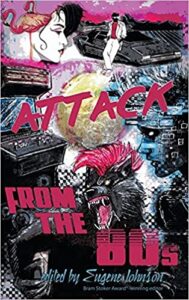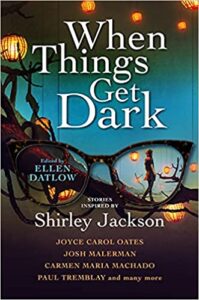A Quaint and Curious Volume of Gothic Tales edited by Alex Woodroe
Brigids Gate Press, 2022
ASIN : B09QHKS4GJ
Available: Kindle edition ( Amazon.com )
Just in time for Women in Horror Month, along comes A Quaint and Curious Volume of Gothic Tales. This anthology of stories by women writers uses the gothic horror tradition to and illuminate the present by giving women a voice. An introduction by Stephanie Ellis provides background on the origins and characteristics of gothic horror and short summaries of each story.
Standout stories include “Penance” by Lindsey King Miller, a heartbreaking tale of a daughter’s unresolved fear, anger, and grief after the death of her estranged mother; “What The Dead Whisper to the Living” by Mary Rajotte, in which a father reveals unspeakable secrets to his daughter; “Picture Perfect” by Patricia Miller, a short, vicious, piece about an artist who pours all her feelings into her work; “Arbor Hills” by Deana Lisenby, a beautiful piece with an unreliable narrator that takes place in an Alzheimer’s unit; “Down with the Holly, Ivy, All” by Jessica Lévai , a Christmas tale of greed and just desserts that feels like it is straight out of Dickens; and “Speak Ill of the Dead” by Briana McGuckin is an entertaining tale about a forensics technician facing the consequences of feeling sympathy for the ghost of a victim she examined. The laginappe, or final story in the book, “The Sweetlings” by S.H. Cooper , could be an episode of The Twilight Zone.
Other good stories include “Mercy” by Catherine McCarthy, which features a man with the supernatural power to end lives peacefully, at a cost; “Slave of the Living Dead” by Kasimma, which moves the gothic sensibility to Nigeria, where a family curse caused by destroying the lineage of a beloved ancestor and selling him into slavery dooms them at age thirty-five; “A Kindness of Ravens” by April Yates, a tale of unhappy marriage, betrayal, sapphic love, and the supernatural; “The Half-Moon Casita” by Anna Fitzgerald Healy, about a couple in an unsatisfactory relationship, each haunted by uncomfortable doubts of the other; and “Scabrous” by Victoria Nations, a disturbing story of a haunted shed.
I appreciated the inclusion of “Slave of the Living Dead” , set outside the typical European locations and culture associated with the gothic tradition,, and would love to see more diverse authors’ interpretations if there is a second volume planned. This is a fine choice for readers wanting to explore the gothic horror genre and celebrate women in horror. The variety of settings, styles, and lengths in this anthology however, means that everyone should be able to find something they can enjoy. Recommended.
Reviewed by Kirsten Kowalewski







Follow Us!